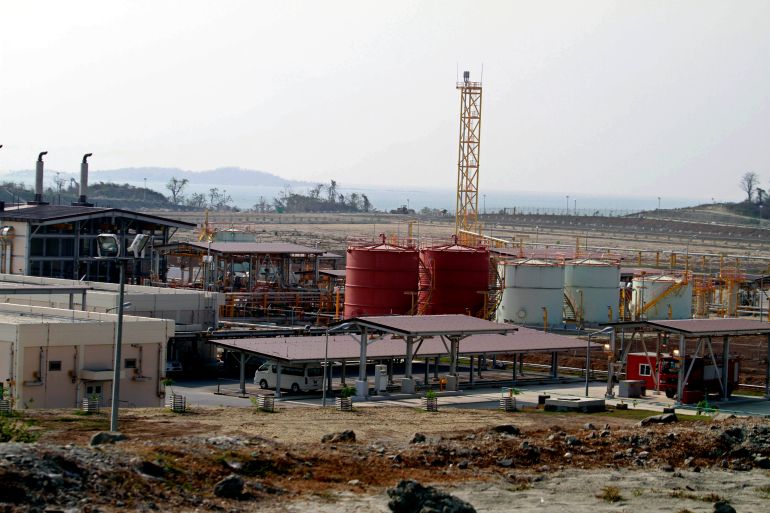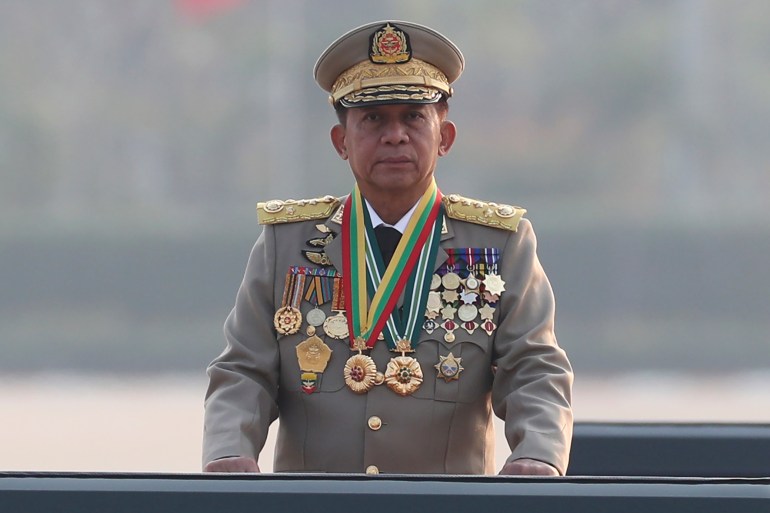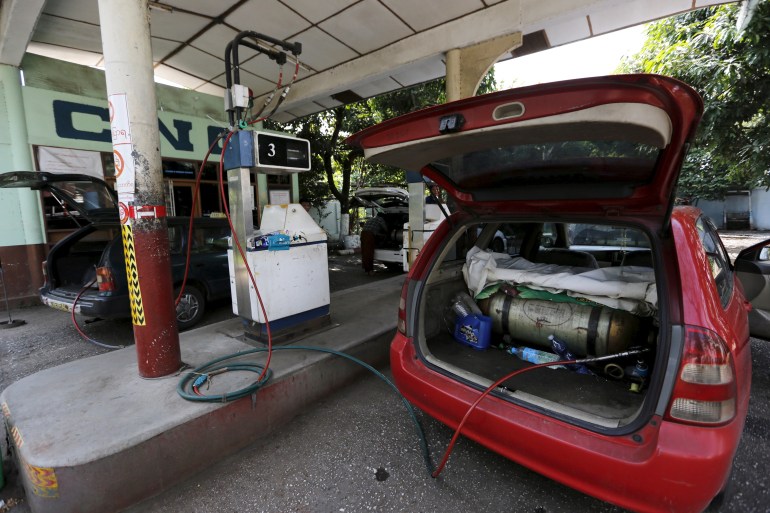For Myanmar’s generals, energy crisis threatens shaky grip on power
Min Aung Hlaing’s administration is hoarding diesel imports, compounding power shortages in Southeast Asian country.

Bangkok, Thailand – Myanmar’s natural gas reserves, a key revenue source for the ruling State Administration Council (SAC), are set to dwindle drastically in the coming years, posing a major threat to the already generals struggling to quell opposition to their rule.
Monthly electricity imports from China to Myanmar more than doubled this year, according to the World Bank, and the country’s post-coup military authorities are pushing ahead with grid interconnection discussions with Beijing and Vientiane.
Keep reading
list of 4 itemsWhat are the implications of Israel’s reported use of AI in Gaza war?
Eleven climbers dead, 12 missing after eruption of Indonesia’s Mount Marapi
ISIL claims responsibility for bombing at Catholic mass in Philippines
The energy crisis facing the SAC has been compounded by recent offensives launched by resistance forces.
Ethnic resistance groups in northern Shan State, coordinating with anti-coup coalitions across the country, pushed the military out of vast areas and took over border crossings and the routes carrying most of the border trade with China.
Senior General Min Aung Hlaing and his forces have responded by hoarding diesel imports to maintain military operations, compounding existing power shortages and plunging the country into a deepening fuel crisis, according to multiple sources in Yangon.

Some petrol stations in Yangon have run out of supply while others have huge queues until late at night, a businessman in the commercial capital said.
“[The cost of] electricity has increased by eight to 10 times since the coup. We need to use generators and the fuel price has gone up a lot,” the businessman, who declined to be named for safety reasons, told Al Jazeera.
“Neither the military nor petrol stations have any control over what’s going on. The regime seems clueless on how such a shortage will hurt the economy,” he added.
Guillaume de Langre, an energy expert and former adviser to the Myanmar government, said there is growing alarm in the country over declining gas production and the military’s hoarding of diesel imports.
“Without gas or diesel, there is no way for hospitals to have reliable electricity to keep medicine and samples cooled, for example,” de Langre told Al Jazeera.
But it is unlikely that either neighbouring China or Laos will export power to Myanmar on a large-scale basis before the country’s gas reserves dry up, experts warn, forcing the SAC to look for alternative energy and revenue sources – or risk facing further legitimacy questions following an almost 20 percent contraction of the economy post-coup.
Myanmar, which was known for levying some of the lowest tax takes in the world before the coup, generated the biggest share of state revenues from offshore gas exports to Thailand and China.
After the military toppled Aung San Suu Kyi’s elected government in February 2021, the state finances sharply deteriorated amid an investor exodus and tax boycott by the public.
The funding squeeze could undercut the ability of the SAC to maintain its operations, including the purchase of weapons, and exacerbate power cuts, potentially engendering even more resistance to military rule.
“Half of Myanmar’s electricity comes from gas. The looming crisis will worsen the current power cuts significantly. Gas exports also account for half of the currency reserves, which the military desperately needs. Energy presents an existential crisis for Myanmar,” de Langre said.
“The gas crisis was expected, but the civilian government was rolling out plans to avert it. But since the coup, the currency depreciation, capital controls and loss of confidence have cancelled all of those plans.”
Power gap
Myanmar faces a huge gap in power following the coup. In May 2021, Myanmar produced around 4000MW of electricity. In recent months, electricity production has hovered between 2500 and 2600MW.
To make things worse, major investors that were developing new offshore gas fields, including French giant Total and Woodside of Australia, have pulled out.
“By 2030, gas production is forecast to be less than one-fifth of its 2022 levels,” said the World Bank in a September report titled In the Dark: Power Sector Challenges in Myanmar.
“In the medium to long term, domestic gas depletion and difficulties in mobilising investment in additional generation sources will likely worsen the power sector situation,” the report added.
The output of Yadana, the biggest gas field, began to fall in 2022 while that of western Rakhine’s Shwe is expected to drop in 2026, according to the report.
“This situation is going to affect Myanmar’s exports to Thailand and China, the hard currency income that it represents for the Myanma Oil and Gas Enterprise, and the amount of gas available for domestic consumption,” the report said.
Production at the Yadana, Zawtika and Shwe gas fields is expected to rapidly decline between 2025 and 2030.
Thailand’s oil and gas giant PTT Exploration and Production (PTTEP) is producing gas at the Zawtika and Yadana fields, while Shwe is operated by South Korea’s Posco International.
“The gas boom since the late 1990s and early 2000s is coming to an end. Essentially, what has provided billions and billions of dollars in funding [for] the Myanmar state and now the regime for the last 25 years is ending,” de Langre said.
“The reservoirs that supply gas to Thailand are going to be depleted in the next few years and this will be a defining aspect of what happens to the SAC: in terms of the relationship between the SAC and Thailand, and the ability of the SAC to fund itself and buy weapons. The money generated by the gas exports has also been used to fund healthcare, education, infrastructure etc. So this will affect the broader population.”
The SAC is pushing ahead with the construction of three dams – Thahtay, Upper Yeywa, Upper Kengtawng – with the aim of getting them up and running by 2026.
The World Bank has warned that insufficient resources and armed conflict have delayed the projects, citing satellite images showing halted progress at the construction sites.
“The three dams, if they come online, will collectively produce 443MW. Solar plants are very small. None of these will plug the gap to take Myanmar to the electricity production pre-coup,” de Langre said.
Since the coup, the SAC has imposed a series of measures that have made the business environment – already seriously affected by conflict – much more difficult, including recently relaxed foreign exchange controls and import restrictions.
Amid an exodus of multinationals, Chinese state-backed energy operator VPower has dramatically scaled back operations in the country.
In its June interim report seen by Al Jazeera, the CITIC Group Corporation Ltd-backed company said it “continued its efforts on scaling down its business and operations in Myanmar and gradually redeploying the assets to other potential projects”.
In partnership with Chinese state firm China National Technical Import and Export Corporation, Hong Kong-listed VPower used to operate five power stations, with four ceasing operations this year. Only one, a 109.7MW plant in Myingyan, is still running.
“Persistent kyat depreciation and dwindling foreign exchange reserves of the country remained the biggest difficulties to foreign businesses,” the company said in the report.
Activist group Justice for Myanmar, citing documents from the Myanmar Investment Commission, has accused VPower of having ties to military conglomerate Myanma Economic Holdings Limited (MEHL) and military-linked company Star Sapphire.

For Justice For Myanmar, VPower, which has publicly denied having military links, represents “a case study of how not to do business in Myanmar”.
Both MEHL and Star Sapphire have been sanctioned by the United Kingdom government.
“Given VPower’s Myanmar operation is owned by a British Virgin Islands holding company, UK authorities should investigate potential violations through payments to these sanctioned companies,” Justice For Myanmar’s Yadanar Maung told Al Jazeera.
Zachary Abuza, a professor at the National War College in Washington, said the energy crisis was the latest example of the post-coup administration’s economic mismanagement.
“It also indicates a shortage in foreign exchange to pay for fuel imports – that’s why foreign companies don’t have confidence – and the difficulty in settling US dollar transactions due to US sanctions,” Abuza told Al Jazeera.
Amid the spiralling crisis, Beijing appears to be stepping in. Electricity imports from China to border trade posts have grown significantly this year.
The average monthly electricity imports from China through medium voltage lines during the first six months of 2023 more than doubled compared with 2022, from 74GWh to 170GWh per month, according to World Bank estimates.
Developing more power import-export capacity with China remains feasible, the World Bank report said, though progress has been slow with new interconnections and transmission lines.
A transmission line for importing 1,000MW of power between Myanmar’s Shan State and China’s Yunnan province has been discussed for years.
But the World Bank said there’s limited progress on discussions between the two utilities on technical design and commercial transactions, and construction of a high voltage interconnected transmission line hasn’t started, either.
“The existing medium voltage line from China isn’t connected to the national grid. Therefore, the electricity imported from China has local importance for areas close to the China-Myanmar border but has limited impact in other parts of the country,” a World Bank official involved in the discussions told Al Jazeera.
Plans to import power from Laos, a small landlocked Southeast Asian country, appear to be moving ahead, too.
The countries’ energy ministries signed a memorandum of understanding in 2018 to build an interconnection line to import 300MW of power through eastern and southern Shan to Meiktila in central Myanmar.
In April, the deal was extended and a notice to proceed was signed to conduct a feasibility study, with the import capacity upgraded to 600MW.
The SAC and the Laos government announced that the interconnection line would reach Myanmar’s eastern town Keng Tung and Meiktila in 2024 and 2026, respectively.
The World Bank assessed that construction could be challenging as the proposed interconnection route will likely pass through conflict-affected southern Wa State.
“Neither China nor Laos will likely massively step up electricity exports to Myanmar in the near future because they need to fulfil their own domestic demand. Energy security comes first,” de Langre said.
The revolutionary National Unity Government, set up by overthrown lawmakers, has warned that they will not honour contracts or projects signed with the regime.
“The ongoing power cuts and fuel crisis shows that the junta has failed to govern. Business deals with the regime, including power projects, would only prolong the junta’s reign of terror against the people of Myanmar,” Sasa, a cabinet minister in the National Unity Government, told Al Jazeera.
“The junta cannot deliver the necessary stability for Chinese and other energy investors in the country. It is in the best interest of both countries to support the emergence of a democratic, stable and federal Myanmar. We aim to rebuild the nation’s energy infrastructure and will welcome responsible investments in this sector,” Sasa told Al Jazeera.